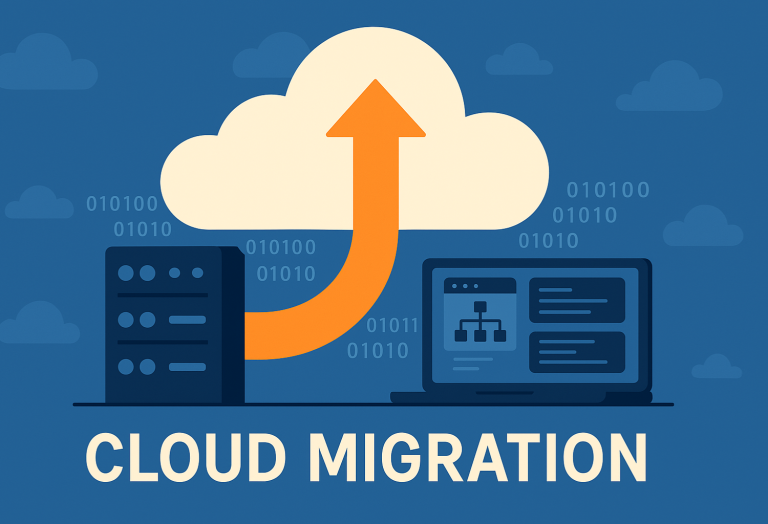
The cloud plays a vital role in every modern and growing organization. As a result, being a transformative technology, the cloud improves efficiency and productivity and saves money. Moreover, several organizations are eager to benefit from the cloud and save on IT costs. Therefore, adopting a cloud-first business strategy is an appropriate option for them to choose cloud-based services over their on-premises alternatives and achieve the desired business advantages.
Gartner analysts say that more than 85% of organizations will embrace a cloud-first principle by 2025 and will not be able to fully execute their digital strategies without using cloud-native architectures and technologies.
What is a Cloud-First Strategy?
A cloud-first strategy is a cost-saving business approach where companies migrate their internal processes to a shared cloud infrastructure. Specifically, in this process, organizations replace their existing software and digital platforms with an integrated cloud service provider. This is primarily because the cloud-first strategy offers easy access to high-end and secure cloud services at an affordable cost.
To understand the cloud-first strategy better, you first need to grasp the basic concept of the cloud. In broad terms, cloud computing can be categorized into three essential tiers:
Software as a Service (SaaS): Cloud-hosted software applications delivered over the internet to end-users. Users can utilize the software on a subscription basis. Example: Microsoft 365
Platform as a Service (PaaS): Software development tool sets that facilitate rapid application development. This environment encourages fast application development in the cloud space. Example: Azure App Service
Infrastructure-as-a-Service (IaaS): Virtualized hardware, operating systems, storage systems, and servers available online. Example: Microsoft Azure
In a traditional business approach, organizations have to purchase every component to continue daily operations (hardware, operating systems, storage, tools, software, etc.). With cloud computing, companies can subscribe to the entire network.
Why Do You Need a Cloud-First Strategy?
There are several benefits to implementing a cloud-first strategy in your organization:
Cost Savings: By incorporating cloud services, you avoid purchasing and maintaining in-house equipment (hardware, software, servers). This significantly reduces Capital Expenditure (CapEx) and Total Cost of Ownership (TCO), lowering overall IT expenses.
It is the responsibility of the cloud service provider to invest in and maintain hardware and other facilities. Even if a disaster strikes, the service provider will restore the system, ensuring that its customers are not financially affected.
Scalability: Organizations may not require the same resources throughout the year. It depends on the type of organization, specific times, and opportunities for a particular business. Companies need to be agile and scalable to seize opportunities and manage seasonal business. Cloud service providers are always ready to offer extra resources and facilities. They also accommodate clients when scaling down usage during temporary drops in demand.
Security: Cybercrimes are becoming more sophisticated over time. Securing an IT system and protecting virtual assets requires significant skills and effort. Security is a crucial aspect for cloud service providers and one of their main selling points. They implement advanced security solutions to safeguard their customers’ business assets. Although cloud-first organizations are not completely immune to cyberattacks, this approach greatly reduces the chance of threat invasion and data breaches.
Disaster Recovery: Disaster recovery is a significant benefit of the cloud-first strategy. In particular, most renowned cloud service providers use geographically-redundant physical server infrastructures, often not located with their clients. Since storage locations are hundreds or even thousands of miles away from the client’s location, resources and digital assets are not affected by local natural disasters and regional outages. Consequently, this allows clients to restore their services promptly after a disaster and continue providing uninterrupted services to their users.
Collaboration: As cloud services are delivered through the internet, they are well-suited for the current distributed work culture. Employees can access the server from anywhere with an internet connection. The importance of easy accessibility and virtual collaboration was clearly demonstrated during the pandemic. Cloud-first organizations could easily switch to remote work or hybrid models, whereas those that had not embraced the cloud struggled to remain operational as their offices closed.
How to Implement the Cloud-First Strategy?
Implementing a cloud-first strategy is a process that requires time and effort. Follow these steps for a successful migration:
Assessment: First, assess the impact of cloud-first implementation on your business — in terms of architecture, mandatory applications, security, and cost. Introduce the idea to your team and conduct a brief pilot run to evaluate the approach’s practicability.
Migration: Firstly, determine the assets you will migrate to the cloud and the migration method based on application and data type. Then, find the most secure data storage option within your budget and start migrating your current assets to the cloud.
Cloud Access: Utilize the applications and tools provided by your cloud solution to improve productivity by automating business functions wherever possible.
Monitoring & Adjustments: After the initial implementation, make adjustments to maximize the benefits from the cloud solution and achieve the highest return on investment. Pay attention to performance monitoring to identify issues and make necessary adjustments.
Conclusion
When you recognize that your organization needs a cloud migration and is ready for a cloud-first strategy, firstly, follow the proper steps for implementation. To begin with, consider your business needs to identify the suitable cloud model. Once you are confident in the benefits of a cloud-first approach, proceed with a migration plan. Next, select a secure storage service provider, migrate necessary assets and data, and leverage cloud applications to boost productivity. Finally, partner with a cloud IT consulting firm to help you implement a cloud-first strategy and ensure a smooth migration journey.







